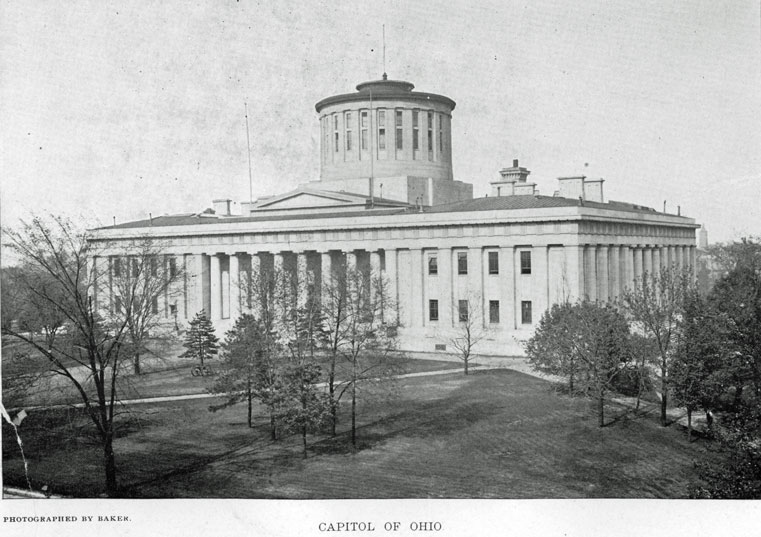
HISTORY
OF THEE
CITY OF COLUMBUS
CAPITAL OF OHIO,
BY
ALFRED E. LEE, A. M.
Author of "European Days and Ways," "Battle of Gettysburg,"
"Sketches and Studies of Leading Campaigns,"etc.
IN TWO VOLUMES..
ILLUSTRATED.
VOLUME II,
PUBLISHED BY
MUNSELL CO.,
NEw YORK AND CHICAGO.
1892.
![]()
FRANKLIN COUNTY COURTHOUSE, COLUMBUS, OHIO
 |
 |
| 12 | 50 | 75 | 100 |
| 125 | 150 | 175 | 200 |
| 225 | 250 | 275 | 300 |
| 325 | 350 | 375 | 400 |
| 425 | 450 | 475 | 500 |
| 525 | 550 | 575 | 600 |
| 625 | 650 | 675 | 700 |
| 725 | 750 | 775 | 800 |
| 825 | 857 |
SEARCH ENGINE
When you reach the page you have been referred to by the search engine, search this page
by going to the top of your browser, click Edit and then click find on this page. Type in the desired search word and click. This will take you to the places on
the page where this word is found. It will take you through all of the places that this word is found on this page
![]()
![]()
ILLUSTRATIONS.xi.
PORTRAITS— Continued. Kilbourne, James Knight, Henry W. Lilley, Mitchell Campbell Lower, Valentine Matzel, George H. McDougal, James D. McKinley, William, Junior Montgomery, James M. Morley, A. T. Neil, Henry M. Neil, John B. Neil, Moses H. Newsom, Logan C. Obetz, Nelson Patton, Alexander G. Peters, George M. Peters, Oscar G. Powell, Thomas E. Pugh, Andrew G. Pulling, James G. Reynolds, William C. Rickly, Ralph R. Saul, John Savage, William M. Shrock, Michael E. Swayne, Noah H. Tallmadge, Theodore W. Watterson, John Ambrose Wege, Charles Wenz, John Wright, George B. |
opposite 128 opposite 528 opposite 16 opposite 272 opposite 224 opposite 800 opposite 384 opposite 464 opposite 360 opposite 112 opposite .416 opposite 144 opposite 624 opposite 608 opposite 208 opposite 64 opposite 152 opposite 400 opposite 544 opposite 304 opposite 352 opposite 312 opposite 736 opposite 48 opposite 32 opposite 8 opposite 176 opposite 632 opposite 576 opposite 792 opposite 168 |
|
PREFACE TO VOLUME II. The completion of this work happens to be simultaneous with the celebration of the four hundredth anniversary of the landing of Columbus. The coincidence is accidental, but appropriate, and in some respects significant. While the story of the Great Discovery is being recounted with special observances in every part of the civilized world, the time is propitious for the consummation o historical record of the most important city bearing the discoverer name. It is an impressive fact that such a record is possible. When Columbus found and took possession of the island of Guanahani, so imperfect was his own knowledge of what he had accomplished that he believed he had touched the eastern confines of the Orient. In this belief he remained to the end of his life. He had no suspicion that an entire hemisphere yet lay between him and India. The islands which he saw were supposed to be a western group of the Indies, and were so named. Four centuries later the capital of a great State, lying in the interior of a vast continent which Columbus never knew to be such, bears his name and commemorates his achievements. The change, the progress implied by this fact is incalculably great. In the social and material development, the history of which has been chronicled in these volumes, we have an admirable illustration of this change. Less than one century ago the ground on which the City of Columbus now stands was covered with a forest as primitive as any which its illustrious namesake saw when he explored the (xiii) xiv - PREFACE. Bahamas, or visited the Orinoco. With miraculous celerity human energy and genius have transformed that wilderness into what we now see and enjoy. But yesterday the poetic seer might have said of it: Behind the squaw's light birch canoe, The steamer rocks and raves, And city lots are staked for sale Above old Indian graves. I hear the tread of pioneers, Of nations yet to be The first low wash of waves where soon Shall roll a human sea. Today that sea, resistless and unresting, sweeps in vast swelling tide over all these hills and valleys. The capital of Ohio is fitly named. A child of the wilderness, it worthily represents the marvelous results of which Columbus the explorer was the harbinger, and to which his voyages led the way. If not a continental city, it is at least a typical one. The commonwealth whichcreated it, and adopted it as a political center, is preeminently a typical American State. Thou art not East, thou art not West, Thou shieldest both with thy broad breast And loyal heart, Ohio. In the population of the State all the elements of American life are fused; in its position and history all the important conditions of American development are found. Such a commonwealth, in growth, in relations and in social fibre so admirably representing America, does well to designate its capital by the name of America's discoverer. What that heroic soul dreamed of and nobly strove after, but died without seeing, our eyes behold. Of the great things of the PREFACE - xv future which now lie beyond our sight as these things lay beyond his, and which will be realized by those who shall come after us, perhaps we are as unsuspecting as was he of what the last four centuries have revealed. ALFRED E. LEE. COLUMBUS, OHIO, October 12, 1892. |